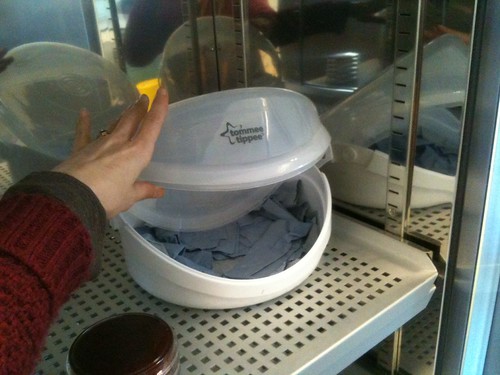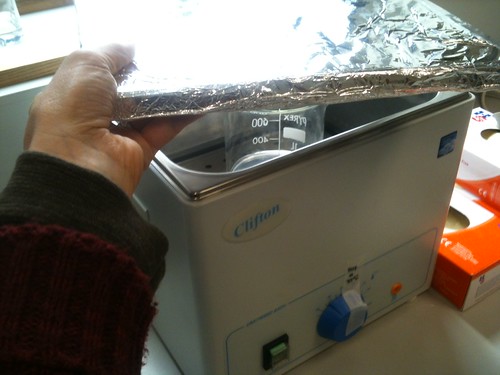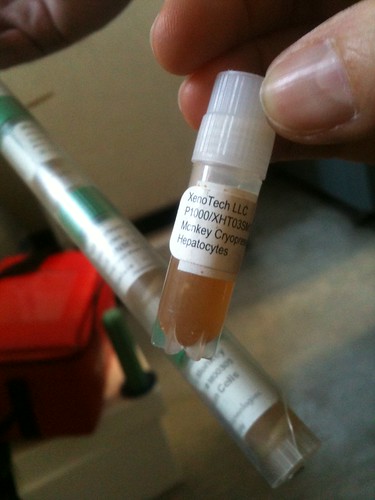Reality check and status update: I’m still a lab head, and I’m still poor.
But after knocking around in this new position for nearly three months, I have to admit that it’s rather good fun being poor. When you lack items that you’ve always taken for granted, you have to come up with all sorts of creative workarounds to do your experiments. I’m not exactly fashioning a Large Hadron Collider out of twigs, tin foil and gaffer tape, but until our next big grant gets funded, there are a few things I really need that we just can’t afford to buy outright.
As it’s Friday, I thought I’d share with you a few of our more ingenious inventions:
1. The poor man’s CO2 incubator:
As I described last time, we have to culture both sterile human cells, and human cells infected with bacteria. But we’ve got only one CO2 incubator, and the sterile human cells get priority. How then to culture the manky stuff? We can get around the CO2 problem by using media that’s buffered to be at the right pH under normal atmospheric conditions, and we have a regular dry incubator for growing bacteria on agar. What about the requirement for achieving over 90% humidity, though? In hunting around the piles of discarded junk we’ve been slowly getting rid of, I stumbled across a strange plastic container called a “Tommee Tippee”. I had no idea what it was at the time (now I know it’s a baby bottle sterilizer, bought in for someone else’s bizarre experiment a few years back), but without its inset, it looked perfect: a sealable container large enough to contain both a tissue culture plate and a bowl of sterilized water – all nestled on moist paper towels.
It worked a treat! All our cells were still alive and happy the next morning. Sorted.
Price: Hardware: FREE. Consumables (paper towels, water): Approx 5p/week.
2. The poor man’s lid:
When I arrived at the lab, I was bequeathed a pile of nearly-new stuff bought off a previous researcher’s grant – the woman had moved on to a non-research job. One of these was a water bath – without a lid. Had it been lost? When I went on the manufacturer’s website to see if I could order a replacement, I realized immediately why the previous researcher had not ordered one: it was sold separately, and it was nearly the same price as the bath itself. After another rummage in the Pile O’ JunkTM, I came up with an appropriately sized piece of plywood; after a nice coat of aluminum foil, it was good to go.
Result: a bit more prone to fungal infections than a real lid, and liable to tear, so we have to change the foil once a week. Still, preferable to sacrificing £150 quid!
Price: Hardware: FREE. Consumables (foil, to be replaced at weekly intervals): Approx 5p/week.
3. The poor man’s N2 tank (a cautionary tale):
OK, so liquid nitrogen is pretty damned cold: −321 °F, to be precise. You can’t just store your samples in tupperware or a Thermos flask. We had no recourse but to buy a proper 30 liter tank, but we went the second-hand route. This wasn’t easy: the UK is a very small country, and there is hardly anything out there. However, we eventually struck gold, purchasing our tank from a charming Yorkshireman called Steve, who was even nice enough to throw in a three-month guarantee, and a random set of storage canes for free.
All fine and dandy, except it soon became apparent that Steve hadn’t bothered to look inside the used tank before he shipped it off:
But no problem: after throwing away the ancient samples of Funky Monkey, we were ready to place a fill order with our friendly neighborhood BOC rep.
Price: Hardware: £400 + VAT (retail price, about £3,500). Consumables (nitrogen): Approx £6/week plus delivery. Free vials of dead monkey hepatocytes: Priceless.
4. The poor man’s shaking bacterial incubator:
Although originally a microbiology lab, the room and kit I inherited had no provision for growing broth cultures of bacteria. Traditionally, you need an incubator with a mechanism for shaking flasks and tubes with extreme vigor so that your bad-assed bugs are properly oxygenated and give high yields. This one was a real bitch to work out, but with a bit of trial and error, my colleague and I cobbled together the following little beaut of a solution.
1. Take tiny 37-degree benchtop incubator and put it on its side on top of a magnetic stir plate.
2. Open the small metal hatch (of completely unknown function) that is now on the ‘floor’ of the incubator, in contact with the stir plate.
3. Sterilize a 25 mL Erlemeyer flask with a magnetic flea inside it.
4. Add water for test run; pierce foil with thermometer to monitor internal temperature.
5. Place flask inside hole left by open hatch (almost a perfect fit, coincidentally) and switch on magnetic stirrer.
6. Turn on incubator and tweak the unmarked temperature dial until a stable 37°C is achieved.
Hypothesis: a vigorous flea-stir will create sufficient oxygenation for the bad-assed bug cultures.
Result: Unknown as of yet – still waiting for my consignment of tryptone and yeast to arrive. But we did manage to keep the test water temperature between 36 and 38°C over a weekend. Unknown as yet whether the incubator will work reliably long-term upended precariously on its side.
Price: Hardware: FREE. Consumables (water, flasks, fleas): FREE.
Next time: Manual PCR in three waterbaths?
I think not.





1) You are my hero. I love this stuff.
2) You have also apparently become rpg. I am confused, but not greatly so.
3) Can you scavenge a big slab of styrofoam from a shipping container and replace your piece of plywood with it at some point? Might be less fungus-y, less likely to grow mold, and more insulating. Just a thought.
4) I might have mentioned this before, but Army Surplus (or electronics surplus, if you have such a thing) stores are a goldmine for useful things like forceps, scissors and whatnot, if you have the time to do a bit of rummaging.
5) I love your “priceless” monkey hepatocytes. I’ll refrain from telling my 1972 Monkey Serum tale again, though.
HAHA, I love if the shaking incubator works. (but many things don’t like being “on the side”…. ah well. I have to admit, I’ve never thought about how much a “tortoise” (that’s what they called them in English-speaking post-doc lab) costs? The one back home in grad school had been there for… ehh… half a century? 🙂 and you might need to grow more than one flask in the future? That said, I do remember the whole “37C room with a shaker plate and when the flasks got loose one night due to some student not doing it proper” … . gah… so maybe you incubator is really quite the new norm?
Happy to read about the inventions to save money. And £150 for a waterbath lid would make me turn to foil too 😉 (really very odd – evil- not to have cheaper separate lids….)
You know, until I got to the end, I *was* about to ask about the manual PCR business. I know people who still do RTs in waterbaths, though. I pointed out that thermal cyclers have all sorts of uses besides for PCR, and are also darned convenient for ligations. But thermal cyclers are a MAJOR money sink right there, as are refrigerators and incubators that keep at something between cold and room temperature. By the way, for an alternative for your bacteria, you might want to look into egg incubators. They’re not a fortune depending on the agricultural supplier, ventilated, and are made to be humid (though more like 60%) and warm (38).
Have you and Richard come up with some new fusional role-swap?
Oh bugger. There’s a reason for that, Winty, which is too tedious to go into here.
I have surfaced here to discover that sometime in the last few hours, I briefly became rpg. We apologize for any inconvenience caused by my rampant technophobia!
Haha..That’s a great post!! we are so spoiled!
And no need to buy centrifuge either; tie the tube to a rope and rotate around yourself!
Heh. You may laugh at @OmicsScience’s suggestion, but my PhD supervisor did exactly this in the field to separate serum in peripheral blood samples (collected in an very rural area), many years ago. It worked for that purpose. I wouldn’t recommend this for, say, membrane preps though. 😉
@OmicsScience and Winty: if it works, why not? 🙂
Jenny, in regards to Heather’s suggestion on an Egg incubator, it might work. Note though, you can’t really adjust the humidity but it will “become what it becomes”… Our big egg incubators are about 45% iwthout eggs, and anything up to 80% with eggs after a few dayes. The small one, well, it’s more on the higher end with 60%.
I should’ve added that I really thought your COincubator – Tommiee Tippi – was very cute and funcitionl! Awesome together.
This. Is. AWESOME. I’ve used makeshift water bath lids before, but didn’t realise that it was probably due to ridiculous pricing strategies rather than a loss or breakage!
I just hope that your grants’ reviewers don’t read this and see how well you’re doing without their money… 😉
One minor correction: “Tommee Tippee” is a brand name, not the name of a particular type of container. Our house was full of Tommee Tippee kids’ cutlery, sippy cups etc. until I was at least 12, because my parents didn’t want to throw it away for some reason. If they’d kept everything they could have donated it to your lab!
I’ve seen people in labs pelleting cells with hand-cranked devices vaguely reminiscent of horizontal bicycle wheels. Microfuges are expensive..!
The something-wrapped-in-tinfoil impromptu water bath lid, BTW, has been de rigeur in all the labs I’ve ever worked in. But we are talking University labs outside the UK’s “Golden Triangle’.
Two things this post is making me look forward to seeing in print (or electronic equivalents)
1.) “Materials and Methods: Cells were cultured in a Tommee Tippee…”
2.) LabLit novel plot around mysterious cells found in secondhand liquid nitrogen tank.
…and on Eva’s note, I LOVE the name on that vial… “XenoTech LLC”. Verrrry mysterious. 😀
P.S. Oh, poo. It’s a real, and respectable-looking, company. 🙁
I worry about you holding the monkey-cell vial without gloves, having flashbacks to a bunch of SciFi movies. There’s your silly oceanographer…
This type of rigging things up and making something out of nothing reminds me of setting up just about any research cruise, but particularly the cruises to the Antarctic Peninsula I was on for my PhD project. There was always something missing, no matter how well you planned – but fortunately there usually were leftover lab supplies from previous cruises, either on the ship or in the warehouse in port, and if you still couldn’t find something you made it with supplies from one of the very old-fashioned but well-stocked hardware stores in Punta Arenas.
Using a lathe to bevel the ends of big acrylic tubes? Good fun 🙂
I guess my thoughts were, if any evil funky monkey cells clinging to the outside of the vial could survive being at -321, they were hardly going to be put off their world domination by a thin layer of latex.
……yeah, good point!
Do you need a stir plate? Home brewers need to culture cells on the cheap, just like the rest of us. My only claim to fame is a 37C chamber for my microscope built out of PVC pipe, plastic sheeting, and a space heater.
http://www.byo.com/stories/projects-and-equipment/article/indices/20-build-it-yourself/401-build-your-own-stir-plate